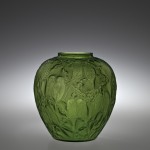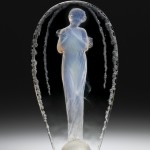It all began in the 1970s, when Elaine and Stanford Steppa would stop at antique shops during Sunday drives. Elaine would purchase affordable works made by French luxury glassmaker René Lalique to use as accessories around the house. When a friend of Stanford’s was given a gift of Lalique glass for 25 years of service upon retirement, Stanford became impressed with Lalique and he too began to purchase Lalique objects.
As the collection grew, Elaine suggested that Stanford learn more about what was worth collecting so that the glass didn’t overtake the house. Stanford then became not only a discriminating collector, but a knowledgeable one. He learned to recognize spurious Lalique objects and fake signatures.
Over the years, the Steppas amassed an impressive collection of 400 Lalique objects that included a variety of pieces, ranging from the famous pressed-glass vases to ashtrays, boxes, clocks, car mascots, lamps, perfumes, statuettes, inkwells and blotters, and tableware.
When the Steppas started thinking about a new home for their collection, they began to discuss The Corning Museum of Glass as a place to preserve and display the collection. Stanford wanted to keep the collection together, and it was important to the Steppas that the objects be in a place where their children and grandchildren could visit. Elaine says, “Although the entire collection won’t all be on display at any one time, it is a legacy that my grandchildren can show to their children when they visit The Corning Museum of Glass and say, ‘I remember when this was in Poppop and Grammie’s house.’”
- Perruches Rene Lalique (French, 1860-1945) France, Combs-la-Ville, R. Lalique et Cie., about 1919 Mold-blown H: 25.1 cm, Diam (max): 24.3 cm Collection of The Corning Museum of Glass, Corning, New York, Gift of Elaine and Stanford Steppa (2011.3.209)
- Worth Perfume Bottle with Stopper and Box, Worth – 1, Dans la nuit (In the night) Combs-la-Ville or Wingen-sur-Moder, designed 1924 Mold-blown glass bottle and mold-pressed glass stopper, acid-etched, applied patina; original hinged box Bottle: H. 7.6 cm, Diam. 5.1 cm Box: H. 6.3 cm, W. 10.6 cm, D. 7.5 cm 2011.3.290, gift of Elaine and Stanford Steppa
- Menu Holder, Poisson (Fish) Combs-la-Ville or Wingen-sur-Moder, designed 1931 Mold-pressed glass, acid-etched H. 14.8 cm, W. 10.4 cm, D. 3.4 cm 2011.3.393, gift of Elaine and Stanford Steppa
- Vase, Escargot (Snail) Combs-la-Ville, designed 1920 Mold-blown glass, acid-etched H. 21.2 cm, W. 19.6 cm, D. 8.1 cm 2011.3.240, gift of Elaine and Stanford Steppa
- Statuette, Grande ovale tête penchée (Large oval, inclined head) Combs-la-Ville, designed 1919 Mold-pressed glass, acid-etched H. 37.2 cm, W. 20.2 cm, D. 9.8 cm 2011.3.201, gift of Elaine and Stanford Steppa
Many collecting groups and other organizations often visited the collection in the Steppas’ home, so they wanted the objects to be housed somewhere where others could enjoy and study the collection. The gift of the Steppa Collection in 2011 made the Museum the preeminent international repository for the study of Lalique glass. The Steppas are also members of the Ennion Society, an honorary group for donors who make annual gifts of $1,200 or more. Donations are used for acquisitions to the Museum’s glass collection, the world’s most important collection of glass, including the finest examples of glassmaking spanning 3,500 years.
“The collection evolved as a labor of love for us, and we are happy that others will enjoy it now too,” says Stanford.
See objects from the Steppa collection on view now in René Lalique: Enchanted by Glass, an exhibition that traces Lalique’s storied career from high-society jeweler to global entrepreneur.







3 comments » Write a comment